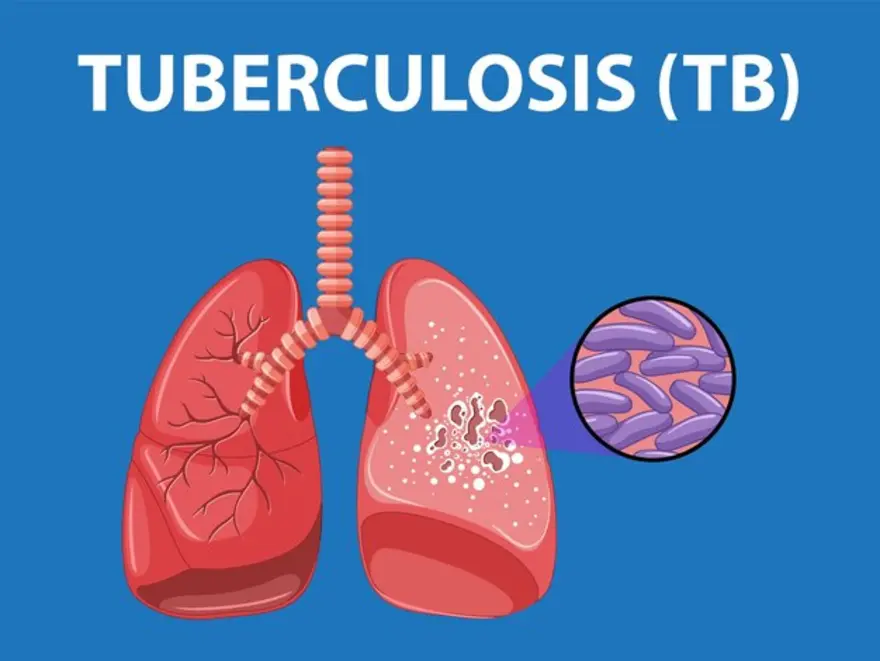Preventive Healthcare
Tuberculosis Decoded: Understanding the Origins, Signs, and Remedies
19071 Views
0

Tuberculosis, commonly referred to as TB, is an infectious disease caused by bacteria. The symptoms of TB can be problematic and can prove to be fatal if left unattended. Therefore, in this blog, we will unravel the enigma surrounding this infectious disease that has left an indelible mark on human history. Stay with this blog as we discuss the causes of tuberculosis, how it happens, what its subtle symptoms are, and unveil the array of treatments that modern medicine has devised to combat this condition.
What is Tuberculosis (TB)?
Tuberculosis is a bacterial infection that primarily affects your lungs but is capable of spreading to other organs of your body.
When you inhale air containing the TB bacteria, these microscopic invaders find a home in your lungs and start multiplying, marking the initiation of the infection. TB usually affects in 3 stages. As the bacteria settle, they form tubercles, clusters that induce inflammation within your lung tissue, marking the primary stage, often characterised by a persistent cough and, at times, chest pain.
Despite the symptoms, the infection can enter a dormant stage for years (latent TB), akin to a hibernation within your body. There is a possibility that this dormant stage will turn into an active TB stage later. Moreover, if your immune system weakens, the bacteria can resurface, leading to the active stage of TB disease.
How Common is Tuberculosis?
You may be surprised to learn that TB remains a global health concern, affecting millions each year.
The World Health Organization estimates that over 10 million people annually contract TB, with around 1.5 million succumbing to the disease. Despite medical advancements, TB persists, particularly in regions with limited healthcare access. Therefore, this is just a reminder that, even in the 21st century, TB continues to impact communities worldwide, emphasising the importance of public health initiatives and global collaboration to address and reduce its incidence.
Are There Different Types of TB?
Certainly, there are different types of tuberculosis, each presenting unique challenges for diagnosis and treatment.
- One distinct type is pulmonary tuberculosis, which affects your lungs and is often characterised by a persistent cough, chest pain, and respiratory issues.
- Extra-pulmonary TB involves infections in organs beyond your lungs, such as the kidneys, bones, liver, brain or lymph nodes, posing diagnostic complexities.
- Multidrug-resistant tuberculosis (MDR-TB) and extensively drug-resistant tuberculosis (XDR-TB) have emerged as formidable variants. MDR-TB resists the two most potent TB drugs, isoniazid and rifampicin, while XDR-TB additionally withstands second-line medications. These drug-resistant forms heighten the difficulty of managing and treating the disease, necessitating specialised approaches.
- Latent TB infection where you may carry the bacteria without exhibiting symptoms.
What Causes Tuberculosis?
Tuberculosis is caused by the bacterium Mycobacterium tuberculosis. While tuberculosis is contagious, it typically requires prolonged exposure to an infected individual for transmission to occur easily. This means that casual contact, such as sitting next to someone on a bus or sharing utensils, will not cause the infection. However, factors like weakened immune systems can increase your vulnerability to TB disease.
How is TB Spread?
Tuberculosis spreads through the air when an infected person with active TB disease expels respiratory droplets into the environment through coughing, sneezing, or talking. These tiny droplets, containing the bacterium Mycobacterium tuberculosis, can be unknowingly inhaled by individuals in close proximity, leading to new infections.
The transmission of TB is more likely to occur in enclosed spaces with poor ventilation, making crowded areas such as public transportation or prisons a higher risk for infection. However, it is important to note that not everyone exposed to the bacteria becomes infected. Factors like the duration and area of exposure, as well as the infectiousness of the source case, play an important role in determining the transmission rates. Moreover, if you are suffering from conditions like HIV/AIDS or malnutrition, you can be more sensitive to contracting and developing active TB after exposure.
What are the Signs and Symptoms of Tuberculosis?
TB symptoms include a persistent cough, often with sputum or blood. Thrdr TB symptoms can be subtle initially, potentially leading to delayed diagnosis.
- Chest pain, fatigue, weight loss, and night sweats are common indicators of TB infection.
- Loss of appetite is another common TB symptom.
- Difficulty breathing and fever may accompany the above TB symptoms.
- Latent TB infection may not present noticeable signs or symptoms.
What Kinds of Tests are Used to Diagnose TB?
Several tests are employed to diagnose tuberculosis, each serving a specific purpose in the identification of the infection:
- Tuberculin Skin Test: The Tuberculin Skin Test (TST) injects a small amount of tuberculin under your skin to assess your immune system's reaction.
- IGRA: Interferon-Gamma Release Assays (IGRAs) measure specific immune system substances released in your body's response to TB antigens.
- Imaging analysis: Chest X-rays or CT scans can detect TB-related abnormalities in your lungs.
- Sputum test: This test examines your respiratory secretions for Mycobacterium tuberculosis, confirming active TB.
- PCR: Molecular tests, like the Polymerase Chain Reaction (PCR), rapidly identify TB DNA for quicker results.
- Culture techniques: Culturing techniques involve growing bacteria from your sample to confirm TB presence and determine drug susceptibility.
How Do I Know if I Should Get Tested for Tuberculosis?
Determining whether you should get tested for tuberculosis involves considering various factors related to your health and potential exposure risks:
- Symptoms: If you are experiencing symptoms of TB, such as a persistent cough, chest pain, fatigue, weight loss, or night sweats, it is advisable to seek medical attention. These symptoms may indicate an active TB infection.
- Contact with TB Patients: If you have been in close contact with someone diagnosed with active TB, you may be at risk of infection. Close and prolonged exposure increases the likelihood of transmission, warranting testing.
- High-Risk Groups: Individuals in high-risk groups, such as those with weakened immune systems (due to conditions like HIV/AIDS or certain medications), healthcare workers, and individuals residing in or travelling to areas with high TB prevalence, should consider testing.
- Health Screenings: If you are undergoing routine health screenings, discuss your risk factors with your doctor. Some healthcare settings may include TB testing as part of routine check-ups.
- Immunosuppressive Conditions: If you are suffering from conditions that compromise the immune system, such as diabetes, cancer, kidney disease or certain medical treatments, you should discuss TB testing with your healthcare provider.
How is TB Treated?
Tuberculosis treatment typically involves a combination of antimicrobial medications to eradicate the bacteria, prevent recurrence, and minimise the risk of drug resistance.
The standard tuberculosis treatment regimen consists of a multi-drug approach, often incorporating isoniazid, rifampicin, ethambutol, rifapentine and pyrazinamide. You should adhere to the prescribed medication regimen for successful tuberculosis treatment and to prevent the development of drug-resistant strains.
Monitoring and periodic assessments are essential throughout tuberculosis treatment to gauge your response and ensure your well-being. With advancements in healthcare, tuberculosis treatment has become more streamlined, offering improved outcomes.
Complications/Side Effects of Tuberculosis Treatment
Tuberculosis treatment, while essential, may pose complications and side effects in your body. Common issues that you may experience include gastrointestinal disturbances, liver toxicity, and skin reactions. Rifampicin, a key medication, can cause your bodily fluids to turn orange, and some drugs may interact negatively with other medications. Severe complications, though rare, may include drug-induced hepatitis.
How Soon After Starting Treatment for Active TB Will I Feel Better?
Improvement in symptoms after starting tuberculosis treatment for active TB varies. While some individuals experience relief within weeks, others may take months. Prompt medical attention, coupled with completing the full course of treatment, increases the likelihood of a quicker response.
Can TB be Cured?
Yes, you can completely cure tuberculosis with appropriate and timely medical treatment.
What Can You Do to Prevent the Spreading of Tuberculosis?
For tuberculosis prevention, you can take several proactive measures. For instance:
- If diagnosed with active TB, make sure you take all your medications and follow your doctor's advice correctly.
- You should attend scheduled follow-up appointments for monitoring to track your progress and adjust treatment as needed.
- If in close contact with a TB patient, undergo testing and consider preventive treatment to minimise the risk of infection.
- Practice good respiratory hygiene by covering your mouth and nose when coughing or sneezing to prevent the release of infectious droplets. Regularly wash your hands.
- Maintain proper ventilation in living and working spaces, as TB spreads more easily in enclosed areas.
- Promote awareness in your community about the importance of early detection, treatment, and following preventive measures.
Is There a Vaccine to Prevent Tuberculosis?
Yes, a tuberculosis vaccine called Bacillus Calmette-Guérin (BCG) exists. Administered in infancy, the BCG tuberculosis vaccine is widely used in countries with high TB prevalence. While it provides partial protection against severe forms of TB in children, its efficacy against adult pulmonary TB varies.
Research into improving the tuberculosis vaccine and developing new ones continues, highlighting the ongoing efforts to tackle this disease.
What is the Outlook (Prognosis) for Someone With TB?
With prompt and adequate treatment, the prognosis for tuberculosis is generally favourable. You can experience improvement within weeks to a few months. Regular medical monitoring ensures effective management and reduces the risk of complications, contributing to a positive outlook for your recovery.
When Should I See My Healthcare Provider?
If you experience symptoms like a bad cough (more than two weeks), chest discomfort, weakness, weight loss, and fever, consult a doctor promptly. Additionally, seek medical attention if you have been in close contact with someone diagnosed with TB. If you are in a high-risk group, discuss this with your doctor.
Conclusion
Tuberculosis remains a global health challenge, and we need more awareness and proactive measures. Early diagnosis, following the doctor's prescription religiously, and preventive strategies are very important. With ongoing research and collective efforts, there is hope for improved diagnostics, treatments, and, eventually, a world where the impact of tuberculosis is significantly reduced. If you or your loved ones suspect TB infection and want to get tested precisely and swiftly, Metropolis Healthcare is the number 1 choice! Offering a diverse range of TB tests such as Tuberculin test, IGRA test, sputum test and other blood tests. So, book your test today!























 WhatsApp
WhatsApp